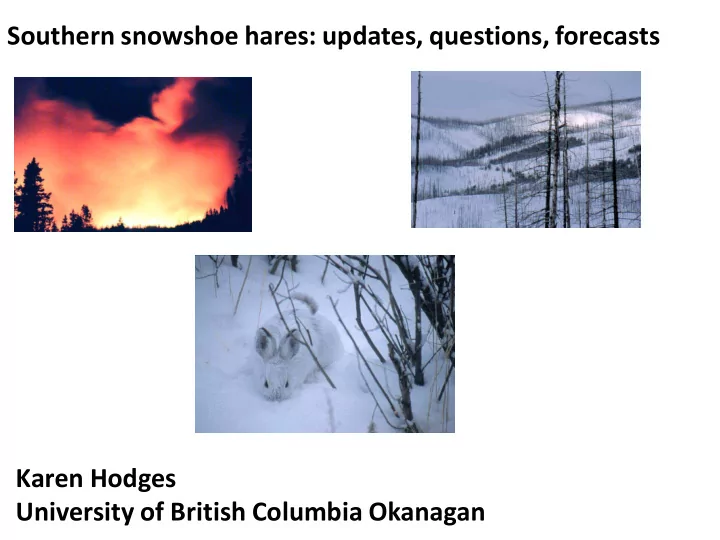

Southern snowshoe hares: updates, questions, forecasts Karen Hodges University of British Columbia Okanagan
MAJOR POINT #1. Northern hare cycles are highly variable. (iffy synchrony, variable peak heights and amplitudes) Krebs et al. 2013. Canadian Journal of Zoology 91:562-572
Is the cycle gradient, as told by textbooks, true? Boreal forest hares years Montane forest hares years
Major stand types in NW Montana “mature” “thinned” “unthinned”
MAJOR POINT #3A. Region matters enormously to hare abundances. 70 Hares / 20 ha in 2002 60 50 40 30 20 10 0 Yellowstone NW Montana we trapped 13 sites: only 4 sites had hares.
Western hare densities differ substantially across landscapes (mostly live-trapping data) NW Montana (2001-12): 0.72 ± 0.12 hares/ha Mills & Hodges unpublished Oregon (2001-2): 0.25-0.42 Washington (2003-4) 0.82 ± 0.07 Abele et al. 2013 Lewis et al. 2009 Wyoming (YNP) (2002-7): 0.20 Wyoming (2006-8): 0.48-1.69 Hodges et al. 2009 Berg et al. 2012 (pellets) Idaho (1998-2000): 0.09 Colorado (2002-3): 0.154 Wirsing et al. 2002 Zahratka & Shenk 2008
Hare densities vary with landscapes further east, too (mostly pellet data) Maine 1.00-1.85 Maine (summary of others): 0-1.8 Homyack et al. 2007 Simons-Legaard et al. 2013 Voyageurs NP, Minnesota (2006-9): ~0.35 hares/ha Moen et al. 2012 northeast Minnesota (2003-6): ~0.64 hares/ha McCann and Moen 2011
Landscape attributes matter to stand quality for hares In North Cascades, WA: hare density increased with: --stand saplings --stand medium trees --“moist forest” within 300 m and decreased with --“open” forest within 300 m. Variables within 300 m more explanatory than variables within 600 m Lewis et al. 2009. Journal of Mammalogy 92:561-567.
MAJOR POINT #3B. Hare population dynamics also differ with region (cyclicity, synchrony, amplitude, and peak densities vary!) 2.0 Montana hares per hectare Yukon 1.5 Yellowstone 1.0 0.5 0.0 2001 2002 2003 2004 2005 2006 2007 2008 2009
What happens to hares when habitats are disturbed?
MAJOR POINT #4A. Forestry actions that reduce stand structure reduce hare abundances. 3.5 Here, experimental precommercial 3.0 thinning in Montana caused declines. 2.5 hares per hectare 2.0 1.5 1.0 0.5 0.0 control thinned control thinned ~1100 m elevation ~1500 m elevation Hodges and Mills, unpublished
In Quebec, hare densities increase with years since commercial thinning 1 m radius circles Bois et al. 2012 . Canadian Journal of Forest Research 42:123-133
And with years post-fire or post-harvest Quebec, Hodson et al. 2011. Canadian Journal of Zoology 89: 908-920
In Quebec, forest age & history matter to snowshoe hares Allard-Duchene et al 2014. Forest Ecology and Management 313:17-25
MAJOR POINT #4B. Fires destroy habitats short-term. has no hares in 2004-2007 has hares 2003 ‘East’ fire in 2002-2003 YELLOWSTONE not good hare habitat in 2011
MAJOR POINT #4C. Hares re-use burned sites as soon as habitat enables them to do so. We sampled 1988 burns in Yellowstone from 2002-2007
Yellowstone stands regenerating after the 1988 fires. . . support few hares, 12 with most sites having none number of sites 10 8 6 4 2 has hares 0 0 <0.1 0.25 - 1 >1 pellets per plot are most likely to have hares if they have high sapling densities 1.5 1.2 pellets 0.9 0.6 0.3 0.0 0 10 20 30 40 50 saplings per 2 m radius circle has no hares Hodges, Mills, and Murphy. 2009. J. Mammalogy 90:870-878
In Glacier National Park, we found similar patterns data 2005-2007 Cheng, Hodges & Mills 2015. Fire Ecology 11:119-136.
High mean—and high variance— in hare density in 1988 burns (17-19 yr post-fire) n=87 n=23 n=4 Cheng, Hodges & Mills. 2015. Fire Ecology 11:119-136
Stands regenerating after 1988 fires: Glacier beats Yellowstone Yellowstone Glacier (2002-2007) (2005-2007) sites with 47% 80% hare pellets maximum density 1.3 2.4 (hares/ha) average density 0.14 0.39 average density 0.27 0.49 for sites with hares Cheng, Hodges & Mills 2015, Hodges et al. 2009
Speculation #1: How many hares do we need to keep lynx around? Problem 1: Tally Lake sites in western MT: regionally high hares, but full of bobcats instead of lynx Problem 2: Yellowstone has very low hare abundances, but has lynx Problem 3: Spatial scales for “regional density” poorly articulated (lynx home range sizes vary, presumably partly in response to hare densities) Problem 4: Lynx diets vary; we know less about red squirrel abundances than hare abundances
Speculation #2: Future distribution and abundance of snowshoe hares With very high confidence: if we completely lose southern boreal / montane forest, hare numbers will decline in those areas. 1. Forest loss (harvest, thinning, fire), will mean fewer hares at least for a few years. Unknown impacts of salvage logging post-fire. 2. We know more about hares and trees than about hares and shrubs. But understory cover and browse are very important to hares. 3. We don’t know much about hares and winter snows (a few regional models, not much local or specific)
Speculation #3: Some hare lineages may be at risk themselves (or may respond differently to upcoming challenges) High gene flow across boreal range High genetic structure in southern range Cheng et al. 2014. Molecular Ecology 23:2929-2942.
Speculation #4: Impacts of climate change on snowshoe hares? 1. Fires, insect outbreaks, changed forest regeneration --habitat structure matters to hares, so changed habitats means changed distribution / abundance 2. Coat colour issues? --mismatch coat / forest floor may increase mortality --molt cue is daylength 2. Changing forest community? --Unclear impacts on hares of different predator communities --impacts of predation by bobcats, fisher, etc. are poorly known compared to raptors, lynx, coyote
Frontiers in snowshoe hare research 1. Explaining regional variation in dynamics, peak abundance 2. Predicting post-fire re-colonization and density 3. Predicting responses to climate change (fires, winter snow pack, forest conditions: molt timing, physiology, demography) 4. Physiology – demography links (predation stress and reproduction)
Recommend
More recommend